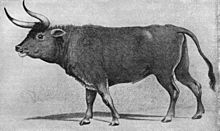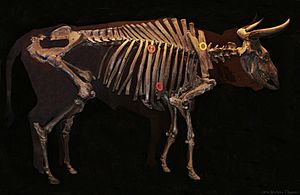Aurochs facts for kids
Quick facts for kids Aurochs |
|
|---|---|
 |
|
| Conservation status | |
| Scientific classification | |
| Kingdom: | |
| Phylum: | |
| Class: | |
| Order: | |
| Family: | |
| Subfamily: | |
| Genus: | |
| Species: |
B. primigenius
|
| Binomial name | |
| Bos primigenius |
|
| Subspecies | |
|
Bos primigenius primigenius |
|
The Aurochs, also called the urus, (Bos primigenius) was a very large type of cattle. It was a wild animal, not like the cows we see on farms today. Aurochs used to live all over Europe, Asia, and North Africa. Sadly, they are now extinct, meaning there are none left alive.
The aurochs was not the same species as the wisent, which is also known as the European bison.
Where Aurochs Lived
According to the Paleontologisk Museum at the University of Oslo, aurochs first appeared in India about two million years ago. From there, they spread into the Middle East and further into Asia. They finally reached Europe around 250,000 years ago.
Today, scientists believe that aurochs and modern cattle (Bos taurus) are actually the same species. Modern cattle are just a much smaller, domesticated version of their wild ancestors.
How Aurochs Looked
Aurochs were much bigger than the cows we see today. A large domesticated cow is usually about 1.5 meters (5 feet) tall. But aurochs were about 1.75 meters (5.75 feet) tall at the shoulder. Imagine a cow that tall!
Aurochs also had some special features that are not common in modern cattle:
- They had lyre-shaped horns. These horns curved forward, looking a bit like a musical instrument.
- Males were black with a pale stripe running down their spine.
- Females and young calves were reddish in color.
- Some modern cattle breeds, like Jersey cattle, still show these colors.
Aurochs were also known for being very aggressive. In ancient cultures, hunting and killing an aurochs was seen as a brave and courageous act.
Types of Aurochs
At one time, there were three different types, or subspecies, of aurochs. These subspecies were found in different parts of the world:
- Bos primigenius namadicus (Falconer, 1859) lived in India.
- Bos primigenius mauretanicus (Thomas, 1881) lived in North Africa.
- Bos primigenius primigenius (Bojanus, 1827) lived in Europe and the Middle East.
Out of these three, only the European subspecies survived until more recent times. The last known aurochs died in Poland in 1627.
See also
 In Spanish: Bos primigenius para niños
In Spanish: Bos primigenius para niños


